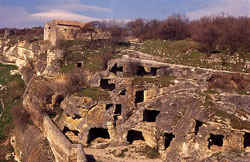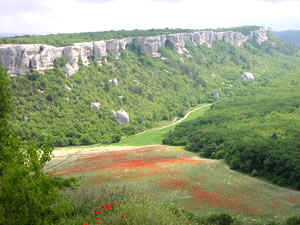
In Antiquity
In the Middle Ages
Near Outlying Areas
Far Outlying Areas
Mangup-Kale cave town
Eski-kermen
Chufut-Kale fortress
Tepe-Kermen site
Bakla cave town
Kyz-Kermen fortress
Kachi-Kal'on cave monastery
Chelter-Marmara monastery
Shuldan monastery
Kyz-Kule site
Mangup-Kale, Eski-Kermen, Chufut-Kale, Tepe-Kermen, Kyz-Kule, Kalamita, Bakla, Kyz-Kermen, Syuyren, Kachi-Kal'on, Shuldan, Assumption Cell, Chelter-Koba, and Chelter-Marmara, all these marvelous sites of medieval Crimea are collectively known as "cave towns." Located on alpine plateaus, with their enigmatic dark cave windows, these monuments have excited the imagination of travelers through the centuries and have become a source of astonishment and admiration.

There were various, the most fantastic ideas of these sites' origin in circulation. For example, the 17th century Turkish traveler Evliya Celebi wrote that "hard stones were toys for people of those days. They smashed rocks to pieces in a moment, like they sliced cheese, and thus built palaces, various, whichever they wanted, dwellings, and meetings rooms also".
When the scholars entered this discussion, their opinions diverged as well. Nowadays, the most of researchers link the origins of the "cave towns" (with the exception of "cave monasteries") to the works of the Byzantine emperors, who, in the late VI and VII century, built a chain of fortifications at approaches to Cherson (medieval Chersonesos), which was the empire's northern outpost, and garrisoned them with local tribes of Goths and Alans, allied to the empire. The idea of the Roman empire restoration within its previous frontiers and Constantinople as its center was proclaimed as early as the period of Justinian I (527-565). To accomplish this task, the emperor began a series of wars in the East and the West and expanded the sphere of Byzantine influence along the northern Black Sea coast.
In Cherson [Chersonesos], the most important of all north strongholds of the empire, he organized wide-ranging building of fortifications; this construction was not restricted to this city only and included the whole south-west Crimean area that belonged to Byzantium. According to Procopius of Caesarea, in order to protect his subjects from the barbarians, Justinian erected the so-called "long walls", which probably traversed the valleys between the mountains. Atop alpine plateaus, the Byzantines erected fortresses, which are known now under the names of Kalamita or Inkerman, Eski-Kermen, Mangup-Kale, Chufut-Kale, Bakla. This construction of the walls and monumental buildings was organized at the local population's expense and supervised by Byzantine military engineers, with participation of builders and workers from Chersonesos.

Later on, from the 9th to the 13th century, some of these fortresses became towns (Eski-Kermen, Mangup-Kale, Tepe-Kermen, Chufut-Kale, Bakla), though two bigger ones became, by the 15th century, the capitals: Mangup-Kale of the Theodoro principality, and Chufut-Kale of the Crimean khanate.